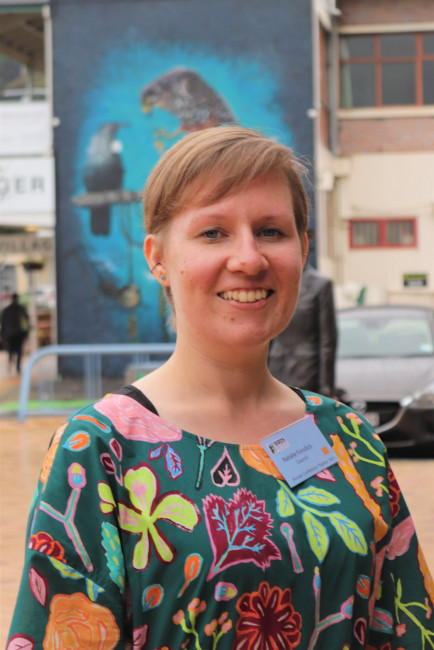Natalie Forsdick dreams of one day seeing kakaruia/Chatham Island black robins in the wild.

A postdoctoral research fellow in the Genomics Aotearoa High Quality Genomes project at Manaaki Whenua Landcare Research, Natalie is applying genomic tools across a range of species including birds, insects, and frogs.
She aims to work with mana whenua and other collaborators to build high-quality genomic resources to support conservation of threatened species.
Current projects include sequencing and assembling reference genomes for species including kuaka/Whenua Hou diving petrels, wētāpunga/giant wētā, huhu beetles, and Hochstetter’s frogs. Not all are threatened with extinction, but the data being generated may facilitate conservation genomics work for related species down the track.
“I’m lucky that I get to do a mixture of lab work and computational work, and have the opportunity to work closely with conservation practitioners, delivering results that inform conservation management actions. It’s really satisfying to see a project through from start to finish, and know that the results will have positive outcomes for the focal species.”
Why bioinformatics?
With ongoing major advances in genome sequencing technology and development of bioinformatic tools, Natalie says working in such a rapidly developing space can be daunting.
“When I was coming through undergrad and Master’s, bioinformatics was still flying under the radar. Most of my knowledge was gained during my PhD, either through googling or through the generosity of my peers. It’s been a relief to find that many of the colleagues I hugely admire for their bioinformatics wizardry actually had a similar start.”
“I definitely recommend checking out the range of workshops provided by the NeSI (New Zealand eScience Infrastructure) and Genomics Aotearoa training teams each year to help emerging researchers upskill. I’m currently at the neat intersection where I’m involved with some of these workshops as a learner and some as an instructor.”
“My biggest advice for newcomers is to ask questions – it will save so much time and angst. Admitting when I don’t know something and asking for help has become my favourite method of combating imposter syndrome – because often I found others struggling with the same problem, and we find a collaborative solution.”
With genomic data sets getting bigger every year, it’s becoming increasingly critical to develop bioinformatics skills. “For me, the project is what gets me excited, and drives my need to develop those new skills. My passion ever since I was little has been conservation, and genetics/genomics has been a great way for me to support threatened species.”
Aotearoa is a small country, but we have an estimated 4000 species at risk of extinction, so it’s crucial that we can increase capacity and capability with these genomic tools to feed into the larger toolbox that includes ecological, physiological, and other related data informing conservation management.
Natalie’s background
Natalie did her Master’s degree at the University of Canterbury, working to understand population genetic diversity and structure in the iconic kakaruia/Chatham Island black robin that is helping to inform conservation translocation decisions
https://link.springer.com/content/pdf/10.1007/s10592-016-0899-1.pdf https://www.tandfonline.com/doi/abs/10.1080/01584197.2020.1812406.
Using samples collected before she joined the project, she has never actually seen a black robin in the wild.
Having had a long-term interest in conservation, this project sparked both an interest in genetics as a means to support conservation efforts, and a rapidly growing obsession with birds. Her interest has expanded to the point that she is now Vice-President of the Birds New Zealand Society.
She completed her PhD at the University of Otago, investigating the genomic impacts of cross-species breeding (hybridisation) in kakī/black stilts, a critically endangered wading bird.
Natalie assembled draft reference genomes for kakī and poaka/pied stilts, and performed downstream population genomic analyses, finding that deliberate conservation management, along with reduced fitness of interspecific hybrids has resulted in no evidence of genomic introgression from poaka into kakī.
These findings support the current Department of Conservation kakī management strategy that excludes hybrid offspring from captive breeding for wild release.
Read more about High Quality Genomes and Population Genomics here